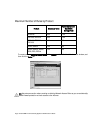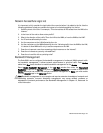Network Access Rules Page 129
Public LAN Server
A Public LAN Server is a LAN server designated to receive inbound traffic for a specific service, such
as Web or e-mail. You can define a Public LAN Server by entering the server's IP address in the Public
LAN Server field for the appropriate service. If you do not have a Public LAN Server for a service,
enter "0.0.0.0" in the field.
Windows Networking (NetBIOS) Broadcast Pass Through
Computers running Microsoft Windows communicate with one another through NetBIOS broadcast
packets. By default, the SonicWALL blocks these broadcasts. If you select From LAN to WAN, your
SonicWALL allows NetBIOS broadcasts from LAN to DMZ or from LAN to WAN. Then, LAN users are
able to view machines on the DMZ and the WAN in their Windows Network Neighborhood.
Windows Messenger Support
Select Enable Support if you are having problems using Windows Messenger through the
SonicWALL. If Enable Support is selected, it may affect the performance of the SonicWALL.
Detection Prevention
Enable Stealth Mode
By default, the SonicWALL responds to incoming connection requests as either "blocked" or "open".
If you enable Stealth Mode, your SonicWALL does not respond to blocked inbound connection
requests. Stealth Mode makes your SonicWALL essentially invisible to hackers.
Randomize IP ID
A Randomize IP ID check box is available to prevent hackers using various detection tools from
detecting the presence of a SonicWALL appliance. IP packets are given random IP IDs which makes
it more difficult for hackers to “fingerprint” the SonicWALL appliance. Use this check box for
additional security from hackers.
Network Connection Inactivity Timeout
If a connection to a remote server remains idle for more than five minutes, the SonicWALL closes
the connection. Without this timeout, Internet connections could stay open indefinitely, creating
potential security holes. You can increase the Inactivity Timeout if applications, such as Telnet and
FTP, are frequently disconnected.


















